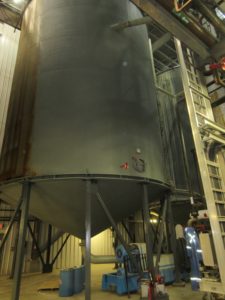This week I had the distinct pleasure of touring the North West Bio Energy ethanol plant in Unity, Saskatchewan.
The raw material used is wheat and the wheat is ground in a disc mill to a fineness not too far different from what any craft distiller would use. But, that was where the similarities ended. The plant employs 4 mash / fermentation vessels that are each about 400,000 Liters in volume (yes you read that number correctly !!). The yeast used is a specially cultured strain of S. Cerevisiae similar in many ways to what craft distillers use, except this stuff spins off daughter cells faster than normal which means a 36 hour ferment will consume all available fermentable sugars in the mash tank. The contents of a completed mash are transferred to a beer well holding tank which feeds the distillation process. The distilling is accomplished by way of 8 columns and the net result is 96% ethanol. In fact, some 75,000 Liters a day of ethanol. The vast majority of this product gets sent to gas refineries. The next time you pull up at the pump and the label on the pump says this gasoline may contain up to 10% ethanol, now you know where the ethanol comes from. To produce fuel grade ethanol, the 96% stuff is passed through a molecular sieve to remove water and make it 99% ethanol. More and more, North West Bio Energy is sending 96% ethanol to custom blending and bottling plants in the USA where it is proofed to 40% and bottled under the guise of “craft distilled” Vodka. There is one plant in the USA that is doing work similar to the one in Unity and it is owned by MGP Products in Lawrenceburg, Indiana. You like Tito’s Vodka? Well, it is just 96% ethanol from Indiana. You like Ketel One? Yep – Lawrenceburg, Indiana. In Canada, you like Banff Ice Vodka? Yep – Unity, Saskatchewan. You like Highwood Rye Whisky? – which Highwood proudly says is based on Wheat distillate with Rye blended in. Yep – Unity, Saskatchewan.
We have now crossed the rubicon as it were, the point of no return. Alcohol is now a commodity and the spoils of victory will go to he who can make it cheapest. Want to be a craft distiller? Go ahead…bust your ass grinding grain and cooking mash. Some guy down the street is going to start making Vodka using the distillate from Unity, Saskatchewan. While you are too busy to get out and sell your product because you are enslaved to a mash tank, the guy down the road who is using Unity’s distillate will have plenty of time to get out and sell his product. In this commoditized game, he wins, you lose.
For the past several years, I have taken a hard stance against craft people who use NGS. But, even crusty old stalwarts like me can soften up. Thanks to this week’s tour of Unity, Saskatchewan I have now come to accept the commoditization of alcoholic spirits. I don’t necessarily agree with it, but I now accept it.
Each month I hear the same mis-guided enthusiasm from people in our Distillery workshops. They say ” yep – gotta make Whisky, Gin and Vodka!!”. My message to them is now going to be made more clear. Whisky, Gin and Vodka are commodities. If you want to be a craft distiller, you need to make variations of these products that are not currently and may never be commoditized. And that is fodder for a future blog post…







